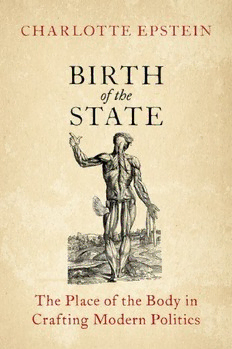
Birth Of The State: The Place Of The Body In Crafting Modern Politics PDF
Preview Birth Of The State: The Place Of The Body In Crafting Modern Politics
Birth of the State Birth of the State The Place of the Body in Crafting Modern Politics CHARLOTTE EPSTEIN 1 3 Oxford University Press is a department of the University of Oxford. It furthers the University’s objective of excellence in research, scholarship, and education by publishing worldwide. Oxford is a registered trade mark of Oxford University Press in the UK and certain other countries. Published in the United States of America by Oxford University Press 198 Madison Avenue, New York, NY 10016, United States of America. © Oxford University Press 2021 All rights reserved. No part of this publication may be reproduced, stored in a retrieval system, or transmitted, in any form or by any means, without the prior permission in writing of Oxford University Press, or as expressly permitted by law, by license, or under terms agreed with the appropriate reproduction rights organization. Inquiries concerning reproduction outside the scope of the above should be sent to the Rights Department, Oxford University Press, at the address above. You must not circulate this work in any other form and you must impose this same condition on any acquirer. CIP data is on file at the Library of Congress ISBN 978– 0– 19– 091763– 0 (pbk.) ISBN 978– 0– 19– 091762– 3 (hbk.) 1 3 5 7 9 8 6 4 2 Paperback printed by Marquis, Canada Hardback printed by Bridgeport National Bindery, Inc., United States of America Contents Acknowledgments vii A Note on References ix 1 Introduction 1 I. SECURITY 2 The Corporeal Ontology of Modern Security 41 3 Denaturalising Security 73 II. LIBERTY 4 From Liberties to Liberty: Crafting Territory and the Law with the Body 105 5 Externalising and Internalising Liberty via Discipline 131 III. PROPERTY 6 Privatising Property 177 7 The Public Anatomy Lesson 217 Conclusion 263 Notes 277 Bibliography 299 Index 315 Acknowledgments This book has taken a long time to write, a longer time still to read for and to think through. Several institutions have hosted me for writing visits along the way. I am grateful to my colleagues at the Centre d’Études et de Recherches Internationales (CERI/ Science Po) in Paris, at the Wissenschaftzentrum (WZB), in Berlin and its wonderful librarians, and at the University of Sydney. Many friends and colleagues have helped the writing process, sometimes without knowing it, sometimes just with a well- placed word at a difficult moment along the way. I am grateful to Kate Johnston, Étienne Balibar and Frank Smith on that score. I would like to thank Jimmy Casas Klausen, James Der Derian, Paul Halliday, Fleur Johns, Alex Lefebvre, Nancy Luxon, Harry Maher, Jeannie Morefield, Ben O’Loughlin, Sarah Phillips, Kim Rygiel, David Schlosberg, Laura Shepherd, David Smith, Sharon Stanley, Rebecca Suter, Ditlev Tamm, Simon Tormey, Carolien Van Ham, and the Press’s two reviewers for taking the time to read sections of the man- uscript. Thank you to Harry Maher for his eagle eye, and to Angela Chnapko from OUP who has been a joy to work with. I am deeply grateful to Jess Whyte and Rob Walker for the thoroughness and the care with which they repeatedly engaged with the manuscript and with my ideas. For his grace, forbearance, and thoughtfulness; for the insights he has sparked throughout the writing, and for his unwavering support through my own doubts, I am grateful beyond words to Ole Wæver. A Note on References I have used the author-d ate system throughout to give the reference of quotations, and the reader will find the full references at the book’s end. Key works by Thomas Hobbes and John Locke have constituted, in addition, my primary textual materials. These are available in many editions. To make the quotations as readily identifiable as possible across different editions, I have cited both chapters and section numbers, in addition to the page of the specific edition that I have used, whose references are also at the book’s end. I have also abbreviated these texts’ titles as I indicate in the list below. For example, Hobbes (L., chap.17[3] 57) refers to Leviathan’s chapter 17, sec- tion 3, which may be found on page 57 in the Hackett edition. Or again (Hobbes, L. 3) refers simply to the political treatise’s third page in the same edition. Locke (EHU, II.chap.31[3] 250), would likewise refer to the second book, chapter 31, section 3 of Locke’s Essay concerning Human Understanding, page 250 in my chosen edition. When referencing his Essays on the Law of Nature, I indi- cate the essay number and citation page. Thus (ELN, iii, 95– 96) refer to the third essay, with the citations to be found on pages 95 and 96. Abbreviations for Thomas Hobbes’s Main Texts Used DC: De Corpore DCi: De Cive DH: De Homine EoL: Elements of Law EoLi: Elements of Law, Part I: Human Nature EoLii: Elements of Law, Part II: De Corpore Politico L: Th\e Leviathan Abbreviations for John Locke’s Main Texts Used CU: On the Conduct of the Understanding EHU: Essay concerning Human Understanding EE: Essay concerning Education ELN: Essays on the Laws of Nature PL: Essay on the Poor Law TT: Two Treatises on Government
